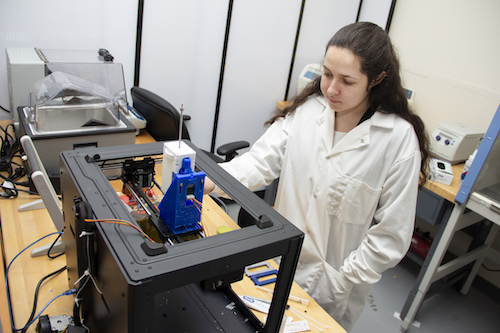From bioinspired to biohybrid
Marika Yang
Dec 13, 2018

Source: College of Engineering
Assistant Professor Webster-Wood joined Mechanical Engineering in Fall 2018.
When we think of robots, we think of metal, machines, and hard surfaces. But robots come in many different shapes and sizes. They have evolved from simply looking like industrial machines to taking physical and behavioral inspiration from biology. These bioinspired robots, in turn, have led to innovations in biohybrid robots, which are made of materials from living organisms.
Assistant Professor in Mechanical Engineering Victoria Webster-Wood uses organic materials to build robotic devices for eventual real-world applications. After joining Carnegie Mellon University in Fall 2018, Webster-Wood established the Biohybrid and Organic Robotics Group (B.O.R.G.) to research and develop biohybrid robots.
“My goal is to create a completely organic autonomous robot that we can program via natural learning pathways to perform specific tasks,” said Webster-Wood. “It’s a very long-term goal.”
My goal is to create a completely organic autonomous robot that we can program via natural learning pathways to perform specific tasks.
Victoria Webster-Wood, Assistant Professor, Mechanical Engineering

Source: College of Engineering
Webster-Wood in the lab.
B.O.R.G. has two main research thrusts. The first is to use organic materials to build the four fundamental components of robotic systems: the structures, actuators, sensors, and controllers. Webster-Wood aims to build devices that can be used for a variety of applications in fields such as medicine and environmental science. The second thrust is to study and develop biohybrid prosthetics, analyzing how to build technologies that will allow them to create large-scale tissues. These tissues will in turn be used to create large-scale muscle for clinical applications.
As a Ph.D. candidate at Case Western Reserve University, Webster-Wood initially began her research in bioinspired robots, looking at animals for design inspiration while using traditional materials and actuators.
“We were always trying to make our robots more robust and more flexible, more adaptable, more compliant, more like animals, doing the crazy things that animals do,” she said. “Muscle naturally addresses these problems. It’s squishy. It has fairly good energy efficiency. It has a pretty good force-to-weight ratio. It ticked all these boxes for what we wanted in our actuators. From there, it organically expanded: if we can use muscle as actuators, what about the other systems?”
In her first semester at Carnegie Mellon, Webster-Wood is looking forward to innovating how we perceive and define robots. To build completely organic robots, she hopes to develop a line of materials made from biological polymers, tissues, and proteins that have well-characterized material properties.
The next step? Cultivate the biohybrid technology to move outside the petri dish and improve the longevity of the robots.
“I want to really start studying how the structure of these different tissues affects their function: are there fundamental design guidelines we can extract to design biohybrid robots? Then we can start building up on that technology towards advanced biohybrid robotic systems.”
Media contact:
Lisa Kulick
lkulick@andrew.cmu.edu